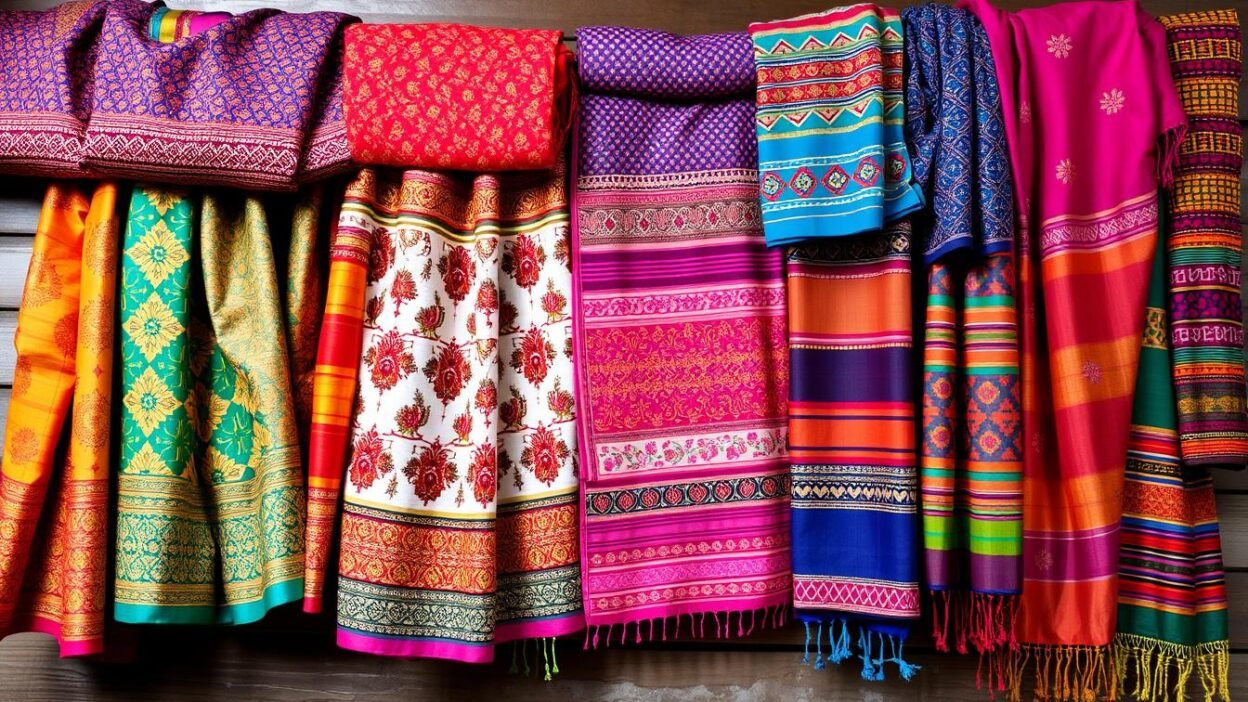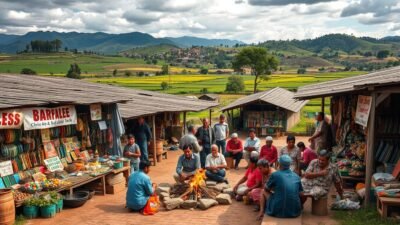India’s textile traditions are a vibrant tapestry of cultural heritage. Each region contributes unique patterns, techniques, and materials to this colorful mosaic. From the Himalayas to Kerala, every area tells its own fabric story.
Home Science students are fascinated by the link between textiles and Indian culture. These fabrics reveal age-old techniques passed down for generations. They showcase how climate, history, and customs shape each region’s textile traditions.
Our journey will take us through Gujarat’s markets and Kashmir’s valleys. We’ll explore Rajasthan’s block prints and Kanchipuram’s lustrous silks. The intricate Ikat weaves of Andhra Pradesh await our discovery too.
This isn’t just about fabrics. It’s a celebration of India’s diverse culture and timeless craftsmanship. We’ll uncover the artistic expression woven into every thread.
Preparing for the UGC NET exam can be a daunting task, but with the right resources, candidates can navigate the process effectively. Websites like MyJRF provide a comprehensive platform for aspiring educators, offering specialized guidance for UGC NET Paper 2 preparation and essential tips for acing UGC NET Paper 1. Additionally, understanding the revised syllabus provided by UGC is crucial for a targeted study approach. For official announcements and updates, candidates should regularly visit the UGC NET NTA portal, while the UGC’s job section and the main UGC website are invaluable for post-exam opportunities and academic resources. With these tools, candidates can maximize their preparation and set themselves up for success.
Key Takeaways:
- India’s textile traditions reflect its vast regional diversity
- Traditional textiles are deeply intertwined with Indian culture
- Each region’s unique climate and history influence its textile crafts
- Home Science studies reveal the cultural significance of these textiles
- Ancient techniques are preserved through generational knowledge transfer
- India’s textiles showcase a blend of artistry and cultural expression
Introduction to India’s Textiles
India’s textile traditions form vibrant threads of its cultural tapestry. These fabrics tell stories of regional diversity and showcase the nation’s rich heritage. From Himalayan peaks to tropical coasts, each area adds unique patterns to India’s textile landscape.
The Importance of Textiles in Indian Culture
Textiles are vital in Indian society. They symbolize status, ritual, and identity. Sarees, dhotis, and turbans reflect regional customs and social standings.
Many homes pass down textile crafts through generations. This often begins with simple Home Science experiments.
“Textiles are the silent storytellers of India’s history, weaving tales of tradition and innovation with every thread.”
Overview of Regional Diversity
India’s textile map is as varied as its geography. The north boasts intricate embroideries, while the south is famous for silks. Western India dazzles with vibrant colors and mirror work.
The east specializes in delicate weaves and natural dyes. This diversity creates a rich tapestry of styles and techniques.
| Region | Signature Textile | Key Technique |
|---|---|---|
| North | Pashmina | Fine Weaving |
| South | Kanchipuram Silk | Zari Work |
| East | Jamdani | Muslin Weaving |
| West | Bandhani | Tie-Dye |
These textiles are crucial to festivals, weddings, and daily life. Each region’s style reflects its climate, resources, and history. This creates a living museum of India’s textile heritage.
Northern India: Colors and Patterns of the Himalayas
Northern India’s Himalayan region showcases a rich tapestry of textile traditions. Each area, from rugged mountains to serene valleys, adds its unique touch to Himalayan textiles.
Unique Fabrics from Himachal Pradesh
Himachal Pradesh is famous for its vibrant woolen shawls and caps. The Kullu shawl, with geometric patterns, symbolizes the region’s weaving expertise.
These colorful creations often feature in Home Science projects. They showcase the state’s rich textile heritage.
Kashmiri Pashmina: A Luxury Treat
Kashmiri Pashmina represents the pinnacle of luxury in Himalayan textiles. Crafted from the softest goat wool, these shawls are prized worldwide.
Their warmth and delicacy make them highly sought-after. The intricate embroidery, known as kashidakari, adds to their allure.
“Pashmina is not just a fabric; it’s a piece of Kashmiri soul woven into every thread.”
The Richness of Garhwali Weaves
Garhwali weaves from Uttarakhand highlight the region’s deep-rooted textile traditions. The pattoo and thulma are staples of Garhwali culture.
Pattoo is a thick woolen fabric, while thulma is a colorful carpet. These weaves often include natural motifs inspired by the Himalayan landscape.
Northern India’s textile traditions reflect the region’s cultural richness. Each fabric tells a story of artisanal skill and heritage passed down through generations.
Western India: Vibrant and Eclectic Traditions
Western India’s textile traditions showcase its vibrant culture. From Gujarat’s needlework to Rajasthan’s prints, the region displays unique craftsmanship. These skills have been passed down through generations.
Gujarat’s Embroidery and Bandhani
Gujarati embroidery is famous for its intricate patterns and bold colors. Artisans use mirrors, beads, and colorful threads to create stunning designs. Bandhani, a tie-dye technique, produces mesmerizing patterns on textiles.
Home Science activities often include learning these traditional techniques:
- Mirror work embroidery
- Bandhani tie-dyeing
- Appliqué work
Rajasthan’s Block Printing Techniques
Rajasthani block printing is known for its intricate designs and vibrant hues. Artisans carve wooden blocks with detailed patterns. They dip these blocks in dye and press them onto fabric.
This technique creates beautiful, repeating motifs on textiles. It’s a unique way to decorate fabric.
| Technique | Region | Characteristics |
|---|---|---|
| Gujarati embroidery | Gujarat | Mirrors, beads, colorful threads |
| Bandhani | Gujarat | Tie-dye, dotted patterns |
| Rajasthani block printing | Rajasthan | Wooden blocks, repeating motifs |
These textile arts help preserve cultural heritage and support local economies. Learning these techniques ensures their survival for future generations. It’s a way to keep traditions alive.
Southern India: Heritage of Silk and Weaving
Southern India’s textile heritage is a treasure trove of intricate designs and vibrant colors. This region’s weaving traditions have thrived for centuries. Let’s discover some iconic textiles from this fascinating part of India.
Kanchipuram Silk: A Classic Treasure
Kanchipuram silk is a symbol of luxury in Indian textiles. These sarees, woven in Tamil Nadu, are known for their durability and luster. Weavers use pure mulberry silk and gold thread to create stunning patterns.
Tradition of Ikat Weaving in Andhra Pradesh
Ikat weaving is a complex technique where yarn is dyed before weaving. Andhra Pradesh is famous for its double Ikat, a highly skilled art form. Both warp and weft threads are tie-dyed to create intricate patterns.
The Dance of Weaving in Kerala
Kerala textiles are known for their simplicity and elegance. The state’s weavers produce various fabrics, including the famous Kerala kasavu sarees. These sarees feature trademark gold borders and motifs inspired by nature and local traditions.
| Textile | Origin | Key Features |
|---|---|---|
| Kanchipuram silk | Tamil Nadu | Heavy silk, gold thread, intricate borders |
| Ikat weaving | Andhra Pradesh | Pre-dyed yarn, geometric patterns |
| Kerala textiles | Kerala | Simple designs, gold borders, natural motifs |
These weaving techniques are part of India’s rich cultural heritage. They can inspire Home Science projects for kids. Children can learn about craftsmanship and cultural diversity through these beautiful textiles.
Eastern India: The Mystique of Natural Dyes
Eastern India’s textile traditions captivate with their use of natural dyes. The region’s rich heritage shines through Bengali sarees and Sambalpuri weaves. These skills have been passed down through generations.
West Bengal’s Sarees and Handlooms
Bengali sarees are known for their delicate designs and vibrant colors. Craftsmen use natural dyes from plants and minerals to create stunning hues. The Jamdani technique, a fine muslin weave, showcases Bengal’s weaving artistry.
Home science ideas often draw inspiration from these traditional methods. Students learn to extract dyes from common ingredients like turmeric and indigo. They apply this knowledge to modern textile projects.
Odisha’s Sambalpuri Weaves
Sambalpuri weaves from Odisha are famous for their distinctive patterns and colors. These textiles feature intricate tie-dye techniques and geometric designs. Weavers use natural dyes to create a palette reflecting the region’s landscape.
| Natural Dye Source | Color Produced | Common Use |
|---|---|---|
| Indigo leaves | Blue | Bengali sarees, Sambalpuri borders |
| Marigold flowers | Yellow | Silk thread dyeing |
| Lac insect | Red | Accent colors in weaves |
Natural dyeing in Eastern India preserves tradition and promotes sustainable practices. This blend of ancient wisdom influences modern textile design. It also shapes home science curricula with its ecological awareness.
Northeast India: Textiles as Cultural Identity
Northeast Indian textiles are crucial for preserving cultural heritage. The region’s ethnic groups express their identity through unique weaving traditions. These textiles tell stories of community, history, and artistry.
The Traditional Weaving of Nagaland
Naga weaving is known for bold patterns and vibrant colors. Each Naga tribe has distinct motifs reflecting their customs and beliefs. These intricate patterns often show nature, warfare, and spiritual symbols.
- Shawls: Symbolize social status and achievements
- Mekhela: Women’s wraparound skirt with tribal designs
- Naga jackets: Adorned with cowrie shells and beads
Assam’s Muga Silk and Its Significance
Assamese Muga silk is famous for its golden sheen and durability. This unique fabric is key to Assamese culture and economy. Muga silk production uses traditional techniques passed down through generations.
| Characteristic | Description |
|---|---|
| Color | Natural golden-yellow |
| Texture | Smooth and glossy |
| Durability | Improves with washing |
| Cultural Value | Symbol of Assamese pride |
Home Science books often showcase Northeast Indian textiles as examples of sustainable fashion. These books highlight the importance of cultural preservation through traditional weaving. Reviving these practices ensures the survival of unique art forms for future generations.
Contemporary Influence on Traditional Weaving
India’s textile heritage faces modern challenges. Artisans adapt traditional techniques to meet market demands. They aim to preserve cultural integrity while embracing change.
This shift reflects growing interest in sustainable textiles. It also shows a focus on ethical production methods.
The Rise of Sustainable Practices
Sustainability is key in India’s textile industry. Artisans use eco-friendly dyes and organic materials. This aligns with Home Science’s definition of responsible resource management.
Weavers now use natural fibers and traditional techniques. They create sustainable textiles that appeal to eco-conscious buyers.
Reviving Old Techniques for Modern Markets
Traditional techniques find new life in contemporary designs. Artisans blend old craftsmanship with modern aesthetics. This revival preserves cultural heritage while serving modern markets.
Designers work closely with weavers on innovative patterns. These designs respect traditional roots while appealing to new customers.
| Traditional Technique | Modern Application | Market Appeal |
|---|---|---|
| Hand block printing | Contemporary home decor | Eco-conscious consumers |
| Ikat weaving | High-end fashion | Luxury market |
| Natural dyeing | Organic clothing lines | Health-focused buyers |
Traditional techniques fuse with modern market demands. This creates unique opportunities for India’s textile industry. Artisans ensure their craft stays relevant by embracing sustainability and innovation.
Celebrating India’s Weaving Masters
India’s textile heritage shines through its master weavers. These skilled artisans keep ancient traditions alive while adapting to modern needs. Their work blends art and function, embodying Home Science principles.
Profiles of Notable Artisans
Let’s explore some of India’s remarkable weavers:
- Govardhan Das: A Banarasi silk expert from Varanasi
- Padma Shri Gajam Govardhana: Ikat weaving master from Telangana
- Jivya Soma Mashe: Warli art pioneer from Maharashtra
These artisan profiles highlight India’s textile industry talent. Each weaver brings unique skills to their craft. Regional influences shape their work, creating diverse textile traditions.
Importance of Preserving Craftsmanship
Preserving craftsmanship is vital for India’s cultural identity and economic growth. It keeps traditions alive for future generations. This practice supports livelihoods in rural communities.
| Aspect | Importance |
|---|---|
| Cultural Heritage | Keeping traditions alive for future generations |
| Economic Impact | Supporting livelihoods in rural communities |
| Innovation | Inspiring new designs in fashion and home decor |
Valuing these skills ensures the survival of India’s textile legacy. Organizations now offer programs in traditional weaving. These initiatives link Home Science to cultural preservation, inspiring future artisans.
How to Appreciate and Purchase Traditional Textiles
India’s textile heritage offers a rewarding experience. Learn to appreciate and buy authentic textiles to understand diverse cultures. This guide helps you explore traditional Indian fabrics and weaves.
Finding Authentic Pieces
Spotting genuine traditional textiles requires keen observation and knowledge. Look for quality craftsmanship: even weaves, vibrant colors, and intricate patterns. Reputable sellers often provide certificates of authenticity.
- Visit government-approved emporiums
- Explore local markets and artisan communities
- Check for quality certifications
Understanding Weaving Techniques and Designs
Know various weaving techniques and textile designs to recognize authentic pieces. Each Indian region has unique weaving styles and motifs. Popular techniques include ikat, brocade, and hand block printing.
| Region | Weaving Technique | Signature Design |
|---|---|---|
| Gujarat | Bandhani | Tie-dye patterns |
| Rajasthan | Block Printing | Floral and geometric prints |
| Odisha | Ikat | Feather-like patterns |
Try Home Science experiments to appreciate textile craftsmanship. Simple weaving projects or natural dyeing techniques offer hands-on experience with traditional methods.
“To truly appreciate authentic textiles, one must understand the stories woven into each thread.”
Studying weaving techniques and textile designs sharpens your eye for quality. You’ll spot authentic Indian fabrics more easily.
Conclusion: The Future of India’s Traditional Textiles
India’s textile heritage faces a crucial moment. Our actions today will shape its future. Fair trade textiles are essential for preserving this art form.
Supporting artisans directly ensures their skills and livelihoods continue. This approach helps maintain the vibrancy of India’s textile traditions.
Encouraging Fair Trade and Artisan Support
Fair trade practices help artisans earn a living wage. This support is crucial for traditional textile techniques to survive.
Organizations now connect weavers with global markets. These efforts bring handmade textiles to wider audiences. They also support local communities in the process.
The Role of Home Science in Textile Education
Home Science projects keep textile traditions alive. Schools and colleges offer courses on traditional and modern techniques.
Students learn fabric design, weaving, and dyeing. This education bridges the gap between ancient crafts and modern markets.
Textile education fosters appreciation for India’s rich heritage. It goes beyond just teaching skills.
Combining artisan support with strong textile education is key. This approach will help preserve treasured traditions for future generations.
FAQ
What is the significance of textiles in Indian culture?
Textiles are deeply woven into India’s social, economic, and cultural fabric. They express art, identity, and provide livelihoods. Traditional textiles often hold symbolic meanings in ceremonies, festivals, and life events.
How does regional diversity influence Indian textile traditions?
India’s vast regional diversity has shaped unique textile styles across different states. Each area has its own weaving methods, colors, and designs. These reflect local culture, history, and available materials.
What are some famous textile traditions from Northern India?
Northern India, especially the Himalayas, is known for its renowned textile traditions. These include luxurious Kashmiri Pashmina, intricate Garhwali weaves, and unique Himachal Pradesh fabrics. Each tradition reflects the region’s climate, culture, and history.
Can you explain the significance of Bandhani and block printing in Western India?
Bandhani and block printing are iconic textile techniques in Gujarat and Rajasthan. Bandhani creates patterns by tying and dyeing fabric. Block printing uses carved wooden blocks to apply designs.
These methods showcase the region’s vibrant style. They’ve been practiced for centuries, playing a key role in local culture and economy.
What makes Kanchipuram silk special among Southern Indian textiles?
Kanchipuram silk is famous for its luxury, durability, and intricate zari work. It comes from Tamil Nadu and is a treasured Southern Indian textile. These sarees are worn at important events and valued for their cultural importance.
How do natural dyes contribute to the textile traditions of Eastern India?
Eastern India, especially West Bengal and Odisha, has a rich tradition of using natural dyes. These dyes come from plants, minerals, and sometimes insects. They create vibrant, long-lasting colors that make Eastern Indian textiles unique.
What role do textiles play in the cultural identity of Northeast India?
In Northeast India, textiles are a powerful form of cultural expression. Each tribe has its own weaving traditions, patterns, and motifs. These reflect their history, beliefs, and social structure.
How are traditional Indian textile techniques being adapted for modern markets?
Traditional Indian textile techniques are being revived for modern markets in various ways. Designers blend traditional methods with contemporary styles. They use sustainable practices to appeal to eco-conscious buyers.
What is the importance of preserving traditional Indian textile craftsmanship?
Preserving traditional Indian textile crafts maintains cultural heritage and supports local economies. These traditions hold centuries of knowledge and are linked to regional identities. Preserving them honors India’s rich history and provides livelihoods for artisans.
How can consumers ensure they are purchasing authentic traditional Indian textiles?
To buy authentic Indian textiles, research reputable sellers and look for certifications. Learn about specific weaving techniques and regional designs. Support fair trade organizations and buy directly from artisan cooperatives.





